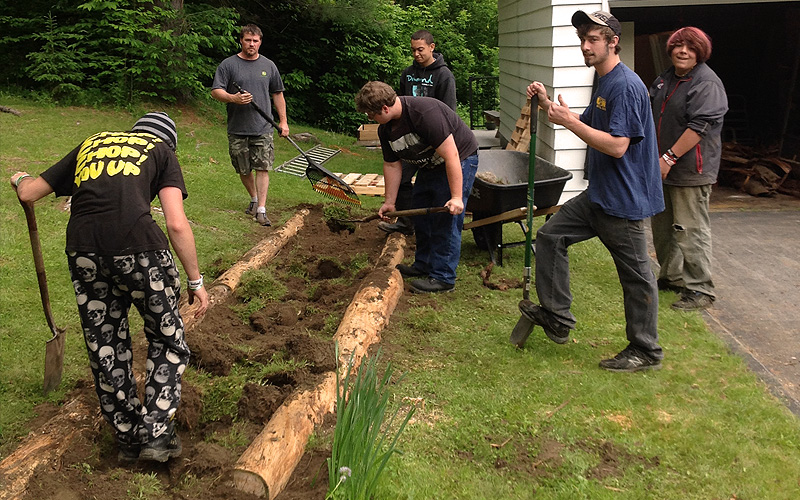
STAR Program students in the garden.
by Chelsey Simpson, communications manager for the National Farm to School Network
As students across the country return to school, many will encounter “classrooms” with rows of garden beds instead of rows of desks. An increasing number of innovative educators are turning to hands-on, food- and agriculture-based education activities to teach everything from math and science to history and literature. These methods not only provide experiential opportunities to teach core subjects, but they also help children gain a deeper understanding of where food comes from, empowering them to make healthy choices for years to come.
One of those innovators is Luke Foley, Vermont’s 2013 Teacher of the Year. Luke draws on his background as a wilderness instructor to help students in Northfield Middle High School’s alternative education program connect with nature and learn to rely on themselves and each other.
Here is his story, in his own words:
I am entering my fourth year as a teacher at Northfield Middle High School’s STAR Program, in Northfield, Vermont. STAR stands for “Students Taking Alternate Routes,” and it’s a program designed for kids who are having a hard time in a traditional classroom setting. Since I’ve been with the STAR Program, we have put a priority on place-based learning, which engages students in their community through service projects. Many of those projects have been food based.
Food is a big part of our way of life in Vermont. Farming has historically been a huge component of our economy and social fabric, and the local- and organic-food movements are foundational to our current economy. But even Vermont is not immune to maladies like childhood obesity, environmental degradation, and loss of family farms, so teaching students about the food they are eating is vitally important.
I find that the best way to teach students about food is to have them participate in growing it. Since year one, our students have been a driving force behind our farm-to-school program. In our first year, we helped to develop our school’s first garden, which produced about 250 pounds of food, all of which was all donated to our school cafeteria.
In year two, we focused on engaging more students and teachers in our process. We raised funds through writing grants to further develop our garden and put in 10 more raised beds. We produced more than 500 pounds of food, which was utilized by our cafeteria, our family- and consumer-sciences classes, and our first Harvest Dinner. Most important, student participation in our garden grew from 6 to 56 percent!
This past year, we secured even more grant funding to put in a greenhouse and quite a few more raised beds as part of a permaculture plan that our students designed. The best thing of all was that the project was student designed and driven. Everything—from planning to grant writing to implementation—was done by our students. I’ll never forget the looks on their faces when they found out that their grant applications had been successful.
On top of our work with school gardens, we’ve also had some partnerships with local farms. Two years ago, we worked with Two Rivers Farm during a period when the students were studying the Middle Ages. They were able to have firsthand experiences of the changes that the agricultural revolution of this time period brought about, while also producing high-quality, organic produce that we donated to the local food bank. That was quite a project!
This upcoming year is going to be the best yet! We just built a wood-fired earthen oven, which will be a learning tool and a fundraising tool. We’re working on expanding the production of our sugar bush (for making our own maple syrup), and we’ll be experimenting with extending our growing seasons using greenhouses and cold frames.
To give you an idea of how far our student-directed projects have come, in just one semester last year, our students raised nearly $20,000 for their projects, which will benefit our school and community for many years to come.
I believe classrooms with four walls don’t work for all kids—honestly, they don’t work best for most kids. We live in a world that needs young people with an ability to “think outside of the box” in order to solve complex real-world issues. How do we teach students to “think outside of the box” when their whole education happens “inside a box?”
By getting into our communities and taking on projects that are meaningful to our students, there is no question about the relevance of what they are learning. I’ve never had a student ask me, “When am I ever going to need this?” They are using what they learn all of the time, in everything they do.
Learn more about Luke, his students’ projects, and the STAR program on his blog, Inspired ED. The National Farm to School Network is an information, advocacy, and networking hub for communities working to bring local-food sourcing and food and agriculture education into schools and preschools. Communities across the country will be celebrating National Farm to School Month this October—learn how you can get involved!




Thank you for being the kind of teacher who knows that not all kids learn as well sitting in a classroom. Kids come in all kinds of packages, and you are smart and kind enough to open the outside of the wrapper and see what the kid inside really needs to get along in this world!! We need more of you. Thank you!
This is a great story on so many levels! Thanks!
I applaud you for your wonderful program. STAR should be in every school district. So many of our students could benefit from hand-on programs.